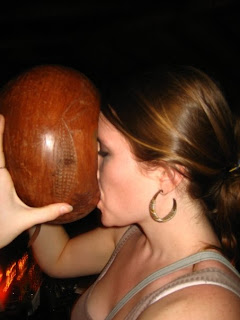
I’m a big fan of puns, so when I read that the slogan for the Ocean Basket seafood joint was “Your Sole Provider,” you could say I was hooked.
At Cape Town’s Victoria and Alfred Waterfront, it’s hard to tell where your best meal is hiding. Herds of tourists disembark from short boat cruises to Robben Island while others stampede through the mall on a hunt for “authentic” wooden salad spoons and carved ostrich eggs. Everyone’s hungry for seafood and it’s nearly impossible to tell the fried fish chains from the real thing. The Ocean Basket may not have been the most glamorous of the area’s offerings, but it certainly wasn’t the seediest either.
I should mention that we had my roommate and his friend in tow, both from Namibia, both sushi virgins and possibly even seafood virgins. Certainly chopstick virgins. That part was fun.
Our table of four decided to share a California roll, a salmon roll, and the Princess Platter. The table’s sushi veterans were unimpressed with the Ocean Basket’s take on those standard rolls that had too much rice and hardly tasted like fish, but we were too busy educating the Namibians to care. It was good that we saved room, however, because the main course was enormous.
The Princess Platter comes with 18 prawns, grilled sole, French fries, fried haloumi cheese, and grilled calamari steaks, all on a bed of spanich rice. The prawns, eyes and claws still intact, felt and tasted like buttery delicious lobster and were just as fun and messy to eat. I’m not usually a fan of calamari, but the little orbs they served were seasoned perfectly and gave me new appreciation for what goes into the glorified fried version you see on so many appetizer menus. The sole was also seasoned and grilled to perfection, and had a texture that reminded me of the ocean’s presence just outside the balcony.
The rice, bright yellow and infused with diced vegetables here and there, had sat patiently on the bottom of the fish, soaking up all the juices and waiting for us to discover it’s presence. The wait was worth it because I have never had rice that moist or flavorful, at least not outside of a risotto. And possibly my favorite part, though it would be impossible to choose, was the haloumi cheese. I think pan-fried cheese should just become a part of every region’s cuisine; those crazy Grecians yelling “Opa!” have the right idea.
Our waiter Wellington kindly wrapped up the massive leftovers we had while we paid the bill—less than ten dollars a person. Once the shock and awe wore off, me and my food baby collapsed on the bus and slipped into a rice-induced coma the whole way home.
